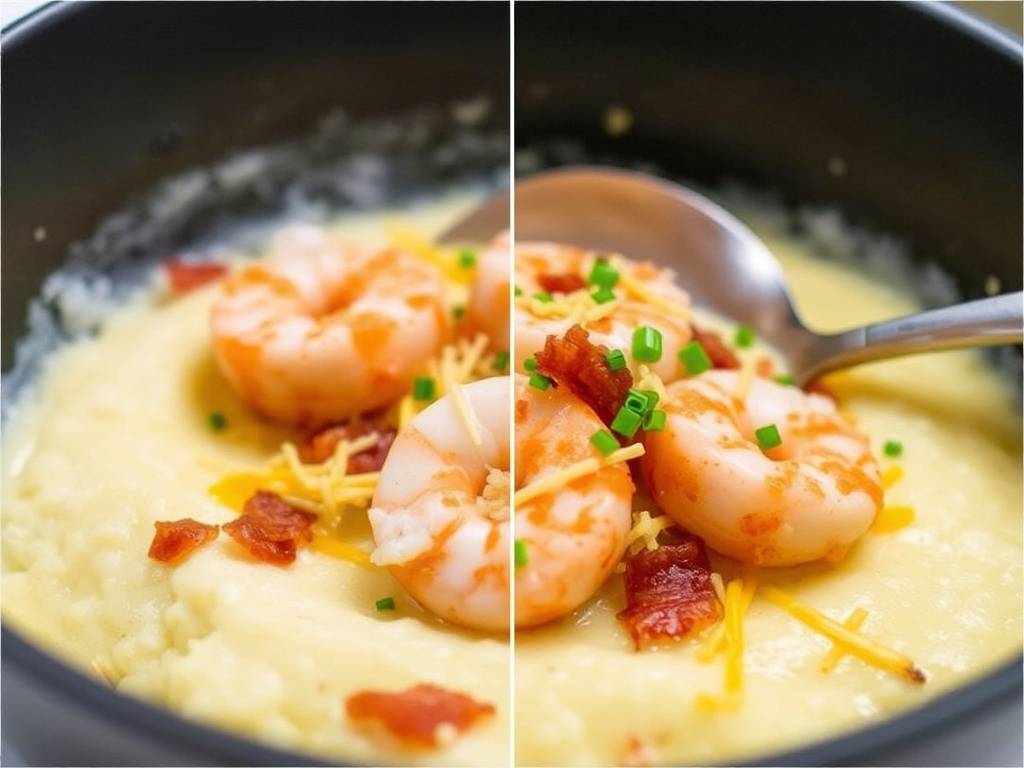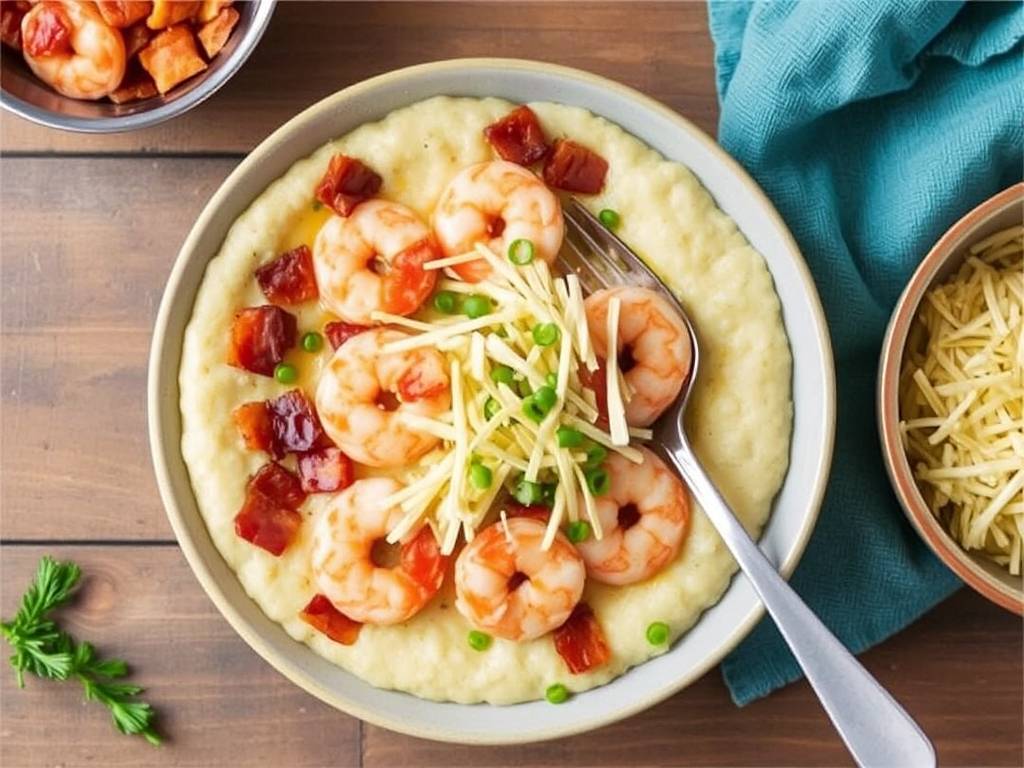Southern Comfort: A Step-by-Step Guide to Crafting the Perfect Shrimp and Grits with Bacon and Cheese
There is a dish that embodies the soul of the American South more profoundly than perhaps any other. It’s a culinary paradox—simultaneously humble and luxurious, simple yet complex. It speaks of coastal waters, fertile fields, and smoky breakfast tables. This dish is Shrimp and Grits. While its roots are firmly planted in simple, rustic fare, modern interpretations have elevated it to a gourmet comfort food staple. The version we will explore today—infused with the smoky saltiness of bacon and the rich, creamy embrace of cheese—is a celebration of flavor and texture that is sure to become a centerpiece of your cooking repertoire.
This guide is more than just a list of ingredients and instructions. It is a journey into the "why" behind the "what." We will delve into the history of the key components, discuss the critical choices you’ll make along the way, and provide detailed techniques to ensure your Shrimp and Grits with Bacon and Cheese is nothing short of spectacular.

Part 1: Understanding the Foundation – The Grits
The grits are the heart of the dish. They are the canvas upon which all other flavors will shine. Getting them right is non-negotiable.
-
Choosing Your Grits: The first and most crucial decision is the type of grits you use. Avoid instant or quick-cooking grits. They are pre-cooked and dried, resulting in a mushy, bland texture that lacks character. For an authentic, creamy result, seek out stone-ground grits. These are whole dried corn kernels coarsely ground between millstones, retaining the germ and hull. This results in a grits with superior corn flavor and a pleasing, slightly textured mouthfeel. They take longer to cook, but the payoff is immense.
-
The Liquid Ratio: Grits are traditionally cooked in water, but for this decadent version, we will use a combination of liquids. A base of water is essential, but we will enrich it with whole milk or, for even more luxury, half-and-half or heavy cream. A standard ratio is 4 parts liquid to 1 part grits by volume, but stone-ground grits may require more liquid and a longer cooking time—always refer to the package instructions.
-
The Cooking Technique: The secret to smooth, lump-free grits is patience and temperature control. Bring your water and milk mixture to a gentle simmer, then slowly whisk in the grits in a steady stream. This initial whisking is critical to prevent clumping. Once incorporated, reduce the heat to the lowest possible setting. Grits must be cooked low and slow, requiring frequent stirring, especially in the first 15-20 minutes, to prevent them from sticking to the bottom of the pot and scorching. Think of it as a meditative process. They are ready when they are tender, creamy, and have lost their raw, gritty taste. This can take anywhere from 45 to 60 minutes for stone-ground grits.
Part 2: The Supporting Cast – Ingredients and Preparation
While the grits simmer, you can prepare the other components. Mise en place—having everything in its place—is key to a smooth cooking process.
-
The Shrimp: Opt for large, wild-caught shrimp (21/25 or 26/30 count per pound) for the best flavor and texture. The most important step for preparing the shrimp is deveining. This removes the digestive tract, which can have a gritty texture. You can leave the tails on for a more dramatic presentation or remove them for easier eating. Pat the shrimp dry with paper towels and season generously with salt, black pepper, and a pinch of paprika or cayenne for a subtle kick.
-
The Bacon: Thick-cut applewood smoked bacon is ideal. Its robust smokiness will render flavorful fat that becomes the cooking medium for the shrimp and vegetables, infusing the entire dish with its essence. Chop the bacon into small lardons (small strips) before cooking to ensure crispy bits are distributed throughout the dish.
-
The Aromatics: The holy trinity of Cajun and Creole cooking—onion, celery, and bell pepper—forms the flavor base. A finely diced onion, a couple of celery stalks, and half a green bell pepper will provide a sweet, savory foundation. Mince 2-3 cloves of garlic to add at the end, preventing it from burning.
-
The Cheese: This is where you can personalize the dish. A good melting cheese is essential. Sharp white cheddar offers a tangy depth, while Gruyère provides a nutty, sophisticated flavor. A combination of the two is sublime. Grate your own cheese from a block; pre-shredded cheese contains anti-caking agents that can make your sauce grainy.
-
The Sauce Components: You will need a liquid to create a pan sauce. Chicken or seafood stock is perfect, but a dry white wine (like Sauvignon Blanc) adds a wonderful acidity that cuts through the richness. You’ll also need a little butter and a splash of fresh lemon juice to finish the sauce, brightening all the flavors.
Part 3: The Culinary Symphony – Bringing It All Together
Now, we assemble the masterpiece. Timing is everything here. Your grits should be nearly finished when you start cooking the shrimp.
Step 1: Crisp the Bacon. In a large skillet over medium heat, cook the chopped bacon until it is brown and crispy. Using a slotted spoon, remove the bacon and set it on a paper towel-lined plate. Leave the rendered bacon fat in the skillet—this is liquid gold.
Step 2: Sauté the Shrimp. Increase the heat to medium-high. Working in batches to avoid overcrowding (which steams the shrimp instead of searing them), add the seasoned shrimp to the hot bacon fat. Cook for about 1-2 minutes per side, just until they turn pink and opaque. They cook very quickly! Do not overcook, or they will become rubbery. Remove the shrimp from the skillet and set them aside with the bacon.
Step 3: Build the Sauce. In the same skillet, you now have a glorious combination of bacon fat and shrimp juices. Add the diced onion, celery, and bell pepper. Sauté for 5-7 minutes until the vegetables have softened. Add the minced garlic and cook for another minute until fragrant. Deglaze the pan by pouring in your white wine or stock, scraping the bottom with a wooden spoon to release all the browned bits (the fond). Let the liquid reduce by half. Stir in a tablespoon or two of butter to create a silky, emulsified sauce. Finish with a squeeze of fresh lemon juice and season with salt and pepper to taste.
Step 4: Finish the Grits. Your grits should now be tender and creamy. Remove them from the heat. Stir in the grated cheese until it is completely melted and incorporated. Then, fold in the crispy bacon bits, reserving a small handful for garnish. The residual heat from the grits will warm the bacon through. Taste and adjust seasoning—the cheese and bacon are salty, so be cautious with additional salt.
Step 5: The Grand Finale. Return the cooked shrimp (and any accumulated juices) to the skillet with the sauce. Toss gently to coat and warm through for just 30 seconds.
To serve, spoon a generous portion of the cheesy, bacony grits into a shallow bowl. Top with the saucy shrimp and vegetables. Garnish with the reserved bacon, a sprinkle of fresh chopped chives or parsley, and an extra grind of black pepper.
Conclusion: A Dish Worth the Effort

Shrimp and Grits with Bacon and Cheese is more than a meal; it is an experience. It is the warmth of the creamy grits, the savory punch of bacon, the luxurious melt of cheese, and the sweet, delicate brininess of perfectly cooked shrimp, all brought into harmony by a bright, buttery sauce. It is a dish that demands your attention and rewards your patience. It is a taste of Southern hospitality, a comforting embrace on a plate, and a testament to the fact that the most memorable dishes are often built from the simplest, most honest ingredients. So, gather your ingredients, embrace the slow stir of the grits, and prepare to create a dish that will delight all who are lucky enough to share it with you.






发表评论